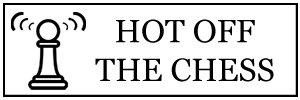
The Isle of Man International Chess Tournament, was being led by Wang Hao and Arkadij Naiditsch going into round five.
The two played each other in this round and notched up a rather quiet draw. The Queen’s Gambit Declined didn’t see much action and soon reached a structure in which there was not likely to be any. On move 36, they split the point.
Maxime Vachier-Lagrave also recorded another draw. The Frenchman had opened the tournament with three straight wins and had taken things a bit easy against Jeffery Xiong in the previous round, drawing in 33.
He was made to fight quite a bit harder in his game with Mircea-Emilian Parligras of Romania. Their Giuoco Piano went to move 57 and I feel that Maxime will have been disappointed to have only come away with half a point. I am wondering if he is perhaps feeling a little bit jaded and has only realised it since the previous round — comfy draws can often have that effect.
Anyway, with the leaders not being able to extend their command at the top, the opportunity to catch up was handed to others. Jeffery Xiong and Abhijeet Gupta said thank you very much.
American Grandmaster, Xiong, beat Richard Rapport with the black pieces, when the Hungarian went badly wrong. As we all know, Rapport likes to play wild openings and take risks and this is what makes his chess so exciting to watch.
Perhaps, however, allowing his opponent to build up a head of steam with a diamond formation of central pawns, was one risk too many. This is shown in the following diagram, with White having played Re8-e6.
Here, Rapport’s sharp attacking style got the better of him and he continued with 35.Nxf4(?). This is a little too much too soon in this position. Obviously, Black can not capture the knight due to Qxe6, winning the rook due to the pinned f-pawn. However, perhaps Richard over-estimated the value of this.
Certainly, after Black’s 35…Rf6, White has the matter of his knight to deal with. The only sensible square for it is e2, which practically begs White to play …d3. This is what happened and it was not overly pleasant for Rapport.
In addition to the threat to his knight, White now has to guard against two nicely advanced passed pawns. Something has gone rather wrong for Rapport and Xiong is now better. And here, 37.Nc3(? Ng3 gave a fighting chance) was a further error.
Jeffery Xiong is not a player who needs to be asked to attack twice. 37…Rg6(!) took a winning advantage. There came 38.Re7, which was inadequate, but there was nothing that wasn’t.
Xiong continued strongly with 38…b4(!) and Black has so many threats, here, White just does not have enough moves to deal with them. In a few moves it was 0-1. This result moved Jeffery Xiong up the standings for a quarter share of the lead.
And joining him there was Abhijeet Gupta. The Indian Grandmaster beat countryman Santosh Gujrathi Vidit as White in a Nimzo-Indian.
This game is actually very enjoyable to play through and is quite illustrative of how chess can very often be decided by very small differences and how to make the most of them. The diagram, below, shows the position after White’s 25.Rc1.
Here, Vidit decided to go for the exchange of Queens with 25…Qd7. Unfortunately, though, this is not the most accurate continuation. Although it is counter-intuitive, Black could well have considered …Nc4 here. This looks horrid due to imposing a pin of the knight to the Queen, 26.b3 is a very natural continuation.
However, to rules there are always exceptions and we have to take the position of White’s own Queen into consideration, here. If 26.b3 (there is nothing better) then Black has 26…Bc6. Anything other than 27.Qb4 would be suicide. And after 27…a5 28.Qe1 (or Qc3), Black would be rather satisfied.
As it was, Vidit had given his opponent the chance to exchange off this not best placed Queen and I doubt that Gupta thought very long about it. Especially because after 26.Qxd7 Rxd7, 27.b4(!) embarrasses the knight. All of a sudden this piece has become a complete liability.
Obviously, the options for the knight to go to are not vast. There is either c6 or c4. After …Nc6, though, White has Bxa6 with an edge. And perhaps this is why Vidit opted for 27…Nc4. Unfortunately, this is no better (and in fact arguably worse) due to 28.Nxd5(!).
White was better and this wasn’t only due to the pawn, but he enjoyed the better activity. After 28…Bxd5 29.Bxc4 Bxc4 30.Rxc4, Gupta owned the c-file and this was going to be tough for Vidit to defend. He tried, but his opponent played a very nice endgame to convert his advantage.
Top Standings after Round 5
Wang Hao, Naiditsch, Xiong, Gupta — 4.5
Vachier-Lagrave, Nakamura, Karjakin, Wojtaszek, Parligras, Jumabayev, Svane — 4.0
A further 27 players are just behind the leaders with 3.5/5. Among these are Aronian, Karjakin, Anand, So, Giri, Adams, Rapport. The event is still wide open with four rounds remaining!

